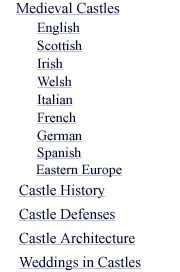


English Castles

Alnwick
Northumberland
Built in the 11th century, this castle is a patchwork of styles fit ingeniously
together to suit the needs of evolving medieval times. Alnwick Castle's
many styles make it a favorite site for learning about medieval architecture.
This castle's impressive curtain wall hides more refined treasure of renaissance
art and the Regimental Museum of Royal Nothumberland Fulisers. The Postern
Tower contains a collection of early British and Roman relics.
Arundel
West Sussex
Arundel Castle began construction in the 11th century and was the site
of three sieges. However two of these castle battles came from within
as the castillians rebelled against the lord. This castle enjoys a spectacular
view if the River Arun and was one of the key defensive points after the
Norman Invasion of 1066. The medieval mound and two baileys still survive,
as does the Bevis Tower, built during the reign of Henry II. Middle Age
architecture was restored in 18th and 19th centuries after having been
destroyed by Parliamentarians. The parish church of St. Nicholas stands
in the castle grounds.
Bamburgh
Northumberland
This red sandstone castle marks the site of one of England's earliest
fortresses. In the 6th century, Ida the Flamebearer made Bamburgh the
stronghold of the kingdom of Bernicia. Its position on an outcrop of rock
has been fortified since prehistoric times.
Nothing remains of the early structures, but Bamburgh Castle is impressive nonetheless. The castle flourished between 1095 and 1464 when it was the royal castle for Northumbrian kings. William the Conqueror laid siege to the castle but found its wall to be impregnable. Bamburgh Castle fared poorly during the Wars of the Roses when it was the first castle to be breached with gunpowder. The late Middle Ages saw this castle fall into obscurity, but it saw new life after being purchased in the late 19th century by a wealthy arms dealer.
Medieval armor, works of art, and other Middle Age artifacts are on display in the castle's basement.
Berkeley
Gloucestershire
Medieval architecture from the 14th century survives virtually intact
in this castle inhabited by the Berkely family. The Berkeley's feared
Edward II would usurp the government of his wife, Isabella, and he was
imprisoned in the castle keep and deprived necessities so he would appear
to have died from natural causes. However, five months later he was still
alive and more drastic measures had to be taken.
The King's Gallery has been preserved to show the conditions of Edward's imprisonment. Medieval art can be seen in the carved Italian doorways that from the entrance to the castle from the courtyard.
Bodiam
East Sussex
Bodiam Castle is a one of the most romantic and beautifully restored medieval
castles in England. Surrounded by a wide moat, this castle was originally
built in the 14th century in anticipation of French attacks. The only
attacks came from within the country, when parliamentarian soldiers damaged
it in an assault during the Civil War of the 1600s.
Medieval mercenaries were housed in Bodiam Castle and special quarters were created to keep them discretely and safely apart from the nobles. Castle towers are open to visitors and can be climbed for impressive views of the moat and countryside.
Carisbrooke
Isle of Wight
Medieval architecture incorporated into earlier Roman stone walls form
the ruins of this castle. Dominating features include the gatehouse and
drum towers, and bulwarks, bastions and curtain walls are still in good
condition. None of the original domestic buildings of this early Norman
castle remain.
This castle was the site of a humorous episode involving the imprisonment of Charles I. He attempted escape through the grilled window bars of the Governor's House after testing the size with his head, however, he got stuck halfway through.
Carlisle
Lancashire
This Norman castle features drum towered gates and was long a defensive
site due to its proximity to the Scottish border. The medieval cathedral
dates from 1133 and has a beautiful east window. This area saw numerous
attacks during the Middle Ages from Danes, Normans and border raiders.
The castle houses a small museum of the King's Own Border Regiment.
Clifford's Tower
North Yorkshire
Stonework of this castle keep was erected in the 13th century, and it
rests on a mound built by William the Conqueror. The outline of the castle
bailey has been perfectly preserved with three more modern buildings.
In 1190, York's Jewish population congregated here to escape a violent mob, but the riot ended in a fearful holocaust and the original tower was burned down. A great gale destroyed the second tower, but in 1244 Henry III commissioned craftsmen to create the present structure.
Colchester
Essex
This 11th century Norman keep is the largest in England. The castle served
as a prison for more humble captives, as the more notorious and famous
were held down the river in the Tower of London. Today it serves as a
museum and its galleries display a fine collection of Roman and British
antiquities.
Donnington
Berkshire
Medieval gatehouses are all that remain of this castle built in the 1300s.
This was primarily a fortified residence until it was destroyed by mortars
during the Civil War of the 1600s.
Dover
Kent
Situated on the famous white cliffs, Dover Castle has been strategically
important for centuries. For nearly 2,000 years, invaders were confronted
by some kind of structure at England's closest point to the Continent.
No other fortification has provided such a central position in defenses
against attackers. For centuries, Dover was England's chain-mailed fist.
William the Conqueror knew the importance of this castle
and made Earl Harold give it up as a prize shortly after the Battle of
Hastings, but it was Henry II who created the
first substantial fortification. Concentric walls and the impressive keep
have been maintained and modernized over the years. Stunning views can
be achieved by climbing to the top of the keep. The castle survived a
siege by French soldiers in 1216.
Beneath Dover Castle lie secret underground tunnels, the earliest of which were constructed during the Middle Ages. Medieval soldiers using these tunnels could leave the castle unseen to launch surprise attacks. The tunnels were occupied by 700 men and women during World War II when it was used as a command post during the Dunkirk evacuation.
Dunster
Somerset
This hilltop fortress evolved from a motte and bailey castle to become
an impressive medieval stronghold. The earliest surviving building dates
from the 13th century, though the main portion of today's castle was built
during Elizabethan times. Descendants of its Domesday Book owners still
live in the castle. Visitors can enjoy the sheltered terrace and walk
in the beautiful parkland.
Durham
County Durham
Medieval stonework grace the outer arch of the gatehouse, and 900-year-old
columns with Moorish-influenced patterns can be seen at cathedral near
this spectacular castle. Durham Castle served as the Episopal Palace until
1832 when it was surrendered to become England's third university.
Framlingham
Suffolk
A castle without a keep, this 12th century fortification has a circuit
of 13 massive towers linked by a wall. Stones from the interior buildings
were used to build a poor house in the 1600s. There may have been some
kind of fortification on this site since the early Middle Ages.
Helmsley
North Yorkshire
Ruins of this castle, including its formidable keep, tower and curtain
walls, dominate the town of Helmsley. Built between 1186 and 1227, this
castle was so solidly built that few attempts were ever made to invade
it. Gunpowder finally brought down the walls during the Civil War. It
is not as large as some of the more famous English keeps, but its 100-foot
curtain walls incorporate more rounded features that kept it safe from
attacking miners.
Herstmonceux
East Sussex
The Royal Observatory is housed in this castle built during the late Middle
Ages. A tall, palatial manor rises from a moat, and though the walls were
too thin to survive an attack, Herstmonceux saw very little military action.
Flemish brick was used to build the structure in 1441, and the 84-foot
high gatehouse and drawbridge were restored early in the 20th century.
Hever
Kent
This 13th century castle would become the childhood home of Anne Boleyn,
the wife of Henry VIII beheaded for adultery. The moat and gatehouse remain
as when they were first built in the 1200s. The castle went through extensive
restoration during the last century.
Kenilworth
Warwickshire
In 1126, Geoffrey de Clinton, Chamberlain to Henry I decided to build
one of the most formidable castles in England. During the Middle Ages,
the streams that feed this lake were dammed and created a mile-long artificial
lake surrounding the castle. The stone keep was built in the early 13th
century and the castle's Great Hall was the scene where Henry V received
a mocking gift of tennis balls from the French ambassador.
Kenilworth was spared damage during the Civil War but it was virtually ignored for centuries and the neglect left nothing but impressive ruins. Only the gatehouse remains habitable.
Lindisfarne
Holy Island, Northumberland
Medieval Irish monks built an abbey on this island that was only accessible
during low tide. There, they created rich, illuminated manuscripts of
the four New Testament gospels that can now be seen in the British Museum.
After numerous Viking invasions, the monks fled, but stones from the abbey
were used to build the castle in 1540.
This castle occupies one of the most romantic sites in all of England and is now owned by the National Trust.
Ludlow
Salop
This castle was built 20 years after the Norman Invasion. In 1634, Ludlow's
Great Hall was the setting for Comus, a court masque written by John Milton.
This celebrated the entry of the Earl of Bridgewater to the presidency
of Wales and the Marches. The castle was salightly damaged during the
Civil War, and was later abandoned. Plays by William Shakespeare are performed
every summer in the open air of the castle grounds.
Orford
Suffolk
The five-sided keep of this castle is unusual, but it is in near perfect
condition. Built during the 12th century by Henry II as a fortified residence.
A maze of rooms, passages, even a two-seat privy are concealed by stone
walls almost ten feet thick. A beautiful spiral staircase can be mounted
from the basement to an incredible view of Oroford Ness and the surrounding
countryside.
Raby
County Durham
Picturesque and beautiful, the bulk of Raby Castle was built in the late
1300s. The castle suffered some damage during the Civil War and was occupied
until 1714. That year, Sir Christopher Vane stripped Raby Castle of its
lead, iron, glass, and doors because his son married against his wishes.
Repairs were made and it is again occupied, but open to the public during
the summer months.
Restormel
Cornwall
Restormel boasts some of the oldest and best-preserved motte and bailey
castles in Cornwall. The keep, Great Hall, kitchens and private rooms
were built around 1100. A simple circular keep was built in the second
half of the 13th century. A large moat surrounded the castle and it saw
action only once during the Civil War when Charles I's forces drove out
the parlimentary garrison. The surrounding fields are covered with flowers
in the spring and is a perfect spot for picnics.
Richmond
North Yorkshire
Medieval architecture is very evident in the ruins of Richmond Castle,
founded in 1071 overlooking the River Swale. The Great Tower rises 100
feet and built in the 13th century over the castle's original gatehouse.
The archway at the base of the keep is one of England's oldest buildings.
Climbing the keep you get impressive views of the Yorkshire countryside
and the medieval market town of Richmond.
Rochester
Kent
One of the greatest medieval sieges took place at Rochester Castle, but
it remains one of the best preserved. The stone keep rises 113 feet and
is the tallest in England. The castle walls are between 11 and 13 feet
thick and a circular staircase leads up to the battlements for an excellent
view of the Kent countryside. Though in ruins, the walls that remain were
built between 1100-1300 and some of the original walls, dating from 1080
still exist.
In 1215, King John laid siege to this castle that had earlier been taken by rebel forces. The king set up camp on the nearby Boley Hill and battles waged for nearly two months. Rochester Castle finally fell at the end of November when the keep was undermined and fat from 40 pigs was used to set fire to the supports.
Rockingham
Northamptonshire
One of England's oldest castles, William the Conqueror ordered this medieval
fortification built in 1095. The site's history dates back much further,
however, as the hill had been occupied by Iron Age, Roman and Saxon tribes.
It became a popular hunting retreat for nobility until it was damaged
in the Civil War. It was leased to the Watson family in 1553, and family
descendants still live in the castle
Charles Dickens visited the castle often and wrote a large portion of Bleak House during his stays there. He reputedly saw Lady Deadlock's ghost behind the 400-year-old yew hedge.
Skipton
North Yorkshire
Though Norman in origin, most of this castle dates from the early 14th
century. Medieval architecture survived a three-year siege during the
Civil War. The stone walls still bear the markings of stonemasons who
carved symbols into the blocks so they could be paid for their work. In
1659, Lady Anne Clifford planted a yew tree in the central courtyard to
mark restoration work after the Civil War.
This castle is open to the public throughout the year.
Stokesay
Salop
Weddings, receptions, honeymoons, or even a night of fine dining can be
experienced in this medieval castle. 13th century stonework and original
timbers can be seen in the Great Hall, and the original towers and gatehouses
are still standing. This castle surrendered and avoided being victim to
a Civil war siege. A moat and curtain wall of stone and lime surrounds
this elegant complex of buildings. A cottage style garden is also open
to the public.
Tamworth
Staffordshire
This castle has a rich history, with architecture dating from the 12th
to 20th centuries. Many rooms are open to the public, including a Great
Hall, dungeon, a haunted bedroom and a permanent exhibition on Norman
Castles. This castle also boasts a fine collection of 16th to 19th century
furniture on loan from the Victoria and Albert Museum in London.
The Pleasure Grounds are set in an attractive park with magnificent floral
terraces and a garden for blind and disabled people. The grounds have
a bowling green, tennis courts, and a picnic area.
Tattershall
Lincolnshire
Two moats and a bailey surround this reconstructed castle. The red brick
keep is four stories high with crenellated parapets and octagonal corner
towers. The keep was used as a garrison for parliamentary troops during
most of the English Civil War.
Tintagel
Cornwall
This castle boasts the origin of King Arthur-in a manner of speaking.
When Geoffrey de Monmouth wrote his History of Britain in 1139, his narrative
romance explained that Arthur was conceived in Tintagel castle. This medieval
castle abounds in mystery and romance as Tristan and Isolt, King Mark,
Uther Pendragon, and Merlin the Magician were all here according to legend.
Mediterranean pottery dating from the 5th century show that this site had been used for trading for centuries. Ruins overlooking the sea are all that remain of the castle, but it still ranks high on the list of castles to visit. The ruins add to the air of mystery and legend.
Tower of London
Greater London
One of the most famous and well-preserved structures in the world, the
Tower of London has a long, and at times, terrible history. William the
Conqueror began construction of the White Tower, which became the most
awesome and frightening building the Anglo-Saxons had ever seen. For more
than 900 years the castle has been constantly improved and extended with
towers and walkways.
The Tower's darker history includes the hundreds of people who were executed, some even as recently as World War II. The Book of Prisoners, kept since the days of William I, lists the names and fates of those unfortunate to have been imprisoned here. The headless ghost of Anne Boleyn is said to haunt the castle, as do the ghosts of Sir Walter Raleigh and others who met their fates within the walls.
The Tower of London is a must for any London
visit, and is home to the famous Crown Jewels.
Warkworth
Northumberland
A late 14th century keep is the most intact part of this castle that was
home to the influential Percy family. Castle ruins dominate the hilltop
overlooking the River Coquet. In 1608 it was reported that Warkworth Castle
was used as a cattle pen, which led to Shakespeare's description of it
as a "worm-eaten hold of ragged stone" in Henry V.
Warwick
Warwickshire
This medieval fortress ranks as one of the most spectacular in England.
Castle construction began in 1086 as a wooden building on a motte, surrounded
by a palisade. Stonework was added in the 12th century, though none of
it survived. Warwick Castle was home to the mighty Earls of Warwick, who
were important in the Wars of the Roses and the Hundred Years War with
France. Richard III started new fortifications and later, the castle was
a Parliamentarian stronghold during the English Civil War.
Medieval apartments were transformed into the Great Hall, which is filled with Middle Age armor, weaponry, and furniture. Caesar's Tower and dungeon contains a gruesome medieval torture chamber. The ghost of Sir Fulke Greville is said to haunt the Watergate Tower. The owners of Madame Tussaud's bought the castle in 1978, and many wax figures were brought in to add a touch of realism. Medieval festivals, jousting exhibitions, and craft demonstrations are held throughout the summer.
Windsor
Berkshire
Queen Elizabeth calls this castle home-one of her homes at least. Windsor
Castle is the oldest, continuously inhabited castle in Britain. William
the Conqueror built the original wooden castle in 1070, and successive
monarchs have made modifications throughout its history.
The royal apartments are open every day, but the private
apartments of the Royal Family are never open to the public. The rooms
contain works of art collected by nobility over the last 4 centuries.
St George's Chapel is the burial site for ten sovereigns and is the spiritual
home of the Knights of the Order of the Garter. Evensong is held in the
chapel at 17:15 daily. The chapel is open every day except Sunday.




